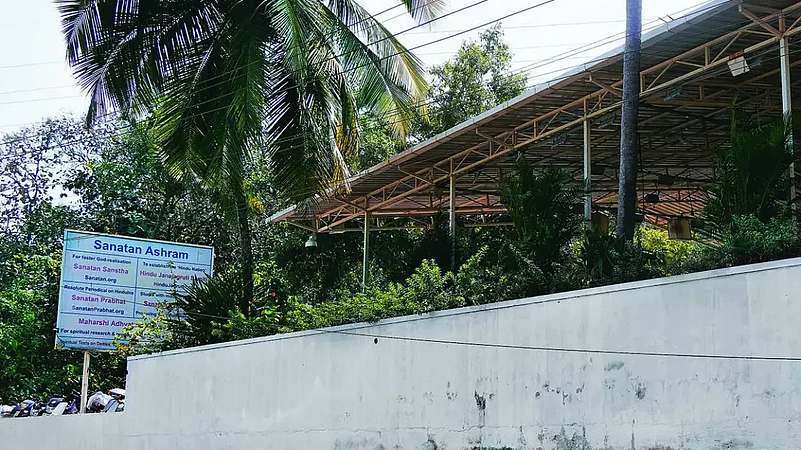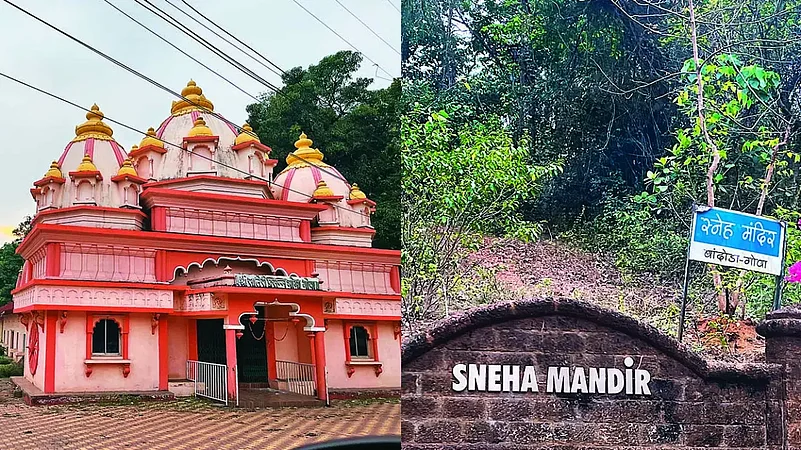The sprawling white-and-yellow building of the Sanatan Sanstha—a hard-line Hindu organisation—stands out starkly against the backdrop of the tree-covered hill in Goa’s Bandora village, about 30 km from the capital Panaji. It appears quiet from outside. A few inmates of the ashram appear to be engaged in manual work in the courtyard. Situated between two of Goa’s most famous Hindu places of worship—the Shantadurga Temple and the Ramnathi Temple—the ashram appears to be an island of peace and serenity. The perfect place to meditate and cleanse the soul for those who come to this place.
For others, the critics of the Sanatan Sanstha, the ashram’s serenity hides the organisation’s frequent brush with controversy, its alleged practice of hypnotising and brainwashing members and its run-ins with the law. But the Sanstha’s national spokesperson, Chetan Rajhans, dismisses the allegations as conspiracies by so-called rationalists and anti-Hindutva forces. “We promote the concept of Hindu Rashtra and we have devoted ourselves to the noble task of Hindu dharma. Therefore, we are always on the hit-list of jihadi terrorists,” he says.
Advertisement
ALSO READ: Tears Of The Mermaid: The Melancholy Of Goa
Headquartered in Ramnathi since 1999, the Sanstha generally prefers to keep away from the spotlight—there is very little information about its membership policy, and the locals are not allowed into the ashram. The Sanstha says it is open only to sadhaks (seekers). According to the website of the Sanstha, individuals are assessed on a scale of 1-100 to access their spiritual maturity. “Those who are members are not accessible. They do not speak. The few who have left the ashram too do not speak. So, there is no way of knowing their membership criteria. There are so many wealthy people who have donated their properties to the Sanstha and have become members,” a source says.
Advertisement

A few people linked to the killing of four well-known rationalists and bomb blasts in Goa and Maharashtra were allegedly members of the Sanstha. Though widely reported, their Sanstha membership has not been proved conclusively. In April 2017, the Maharashtra government sent a proposal to the Centre seeking a ban on the Sanstha under the Unlawful Activities Prevention Act (2011), the Business Standard had reported. Damodar ‘Bhai’ Mauzo, writer and a Jnanpith awardee, finds the presence of the Sanstha is the tiny state to be incongruous. “The people in Goa are peace loving and there is communal harmony here,” Mauzo tells Outlook. “It is a radical organisation and very secretive. There is no way of knowing what is going on inside the complex.” Mauzo is a well-known critic of the organisation.
Founded in 1990 by Dr Jayant Balaji Atavale, a hypnotherapist, the Sanstha is registered as a charitable organisation. Athavale, an alumni of the Grant Medical College, practised as a consultant psychiatrist and a clinical hypnotherapist in Mumbai and later in the UK for nearly two decades. Of the Sanstha’s founding members, only Athavale remains in charge. Athavale’s wife Kunda left the ashram in 2003 while his close associate Prabhudesai parted ways in 2009 after a bitter fight with Athavale. In 2009, Prabhudesai filed an affidavit in a Panaji court in which he said his wife was indoctrinated by Athavale. The organisation has in the past denied all allegations of it being a cult organisation and says that it is a place for spirituality and science. According to sources, the Sanstha is run by a tightly-knit core group close to Athavale. Even the sadhaks do not know who constitutes this core group, said sources.
Advertisement
The Sanstha’s website gives instructions to the sadhaks on how to live, bathe, pray and even urinate in a “spiritually scientific” manner. The Sanstha decided to shift its base from Mumbai to Goa after the bomb blasts in Mumbai in 2008.
According to police records, in 2009, Vinayak Talekar, Dilip Mangainkar, Dhananjay Ashtekar, Prashant Juvekar and Vinay Patil—all alleged members of the Sanstha—were arrested for the role in bomb blasts in Margao in Goa on October 16, 2009. Two other members reportedly belonging to the Sanstha were killed when the IED they were ferrying detonated prematurely. The investigation into the blasts was handed over to the National Investigation Agency (NIA). In 2013, the NIA received a major setback when all the accused were acquitted by a special court at Mapusa (Goa) in December 2013 citing lack of evidence. Though an appeal was filed against the acquittal order in 2014 in the Bombay High Court, sources stated that the case is moving at a snail’s pace.
Advertisement

According to court records, in 2011, Ramesh Hanumant Gadkari and Vikram Vinay Bhave—both reportedly members of the Sanstha—were sentenced to 10 years’ rigorous imprisonment for their role in the bomb blasts at a Panvel cinema and at an auditorium in Thane, both in Maharashtra. While the Hrithik Roshan starrer Jodhaa Akbar was being screened at the Panvel cinema when the blast took place, the Marathi play Amchi Pachpute—which according to the Sanstha showed Hindu gods and goddesses in a negative light—was being staged in the Thane auditorium. Police had also recovered low intensity explosives from an auditorium in Vashi in Navi Mumbai, which was also staging the same play.
Advertisement
In 2013, the spotlight fell on the Sanstha yet again, when it was allegedly linked to the murder of well-known rationalist Dr Narendra Dabholkar, a strong voice against superstitious practices and a critic of the Sanstha. He was shot dead in Pune. In 2015, popular Communist writer Govind Pansare was gunned down in Mumbai and Kannada scholar and Sahitya Akademi awardee in Kannada M.M. Kalburgi was shot dead in Dharwad by assailants who had alleged links with the Sanstha. According to police records, in 2016, Sameer Gaikwad—a member of the Sanstha since 1998—was arrested in the the widely-publicised murder of Dabholkar.
Advertisement
On September 5, 2017, journalist-activist Gauri Lankesh was shot dead outside her home in Bengaluru. Like Pansare and Kalburgi, she too was a vocal critic of the Hindu right-wing. In its investigation report, the CBI mentioned that weapons used in the murders of Dabholkar and Pansare matched the one used in the Kalburgi murder. The Special Investigation Team (SIT) probing the Lankesh case also stated that she was gunned down by the same weapon used in the Dabholkar, Pansare and Kalburgi killings. Investigators had found incriminating emails in the laptop of Dr Virendra Tawde, reportedly a Sanstha member and an alleged mastermind of the Dabholkar murder.
Advertisement
In the Dabholkar case, the examination of eyewitnesses began in a Pune court in March this year, while in the Kalburgi case the evidence is being heard in a Dharwad court. In the Pansare case, the draft charges have been submitted to the court by the prosecution and the filing of charges is awaited, Harshad Nimbalkar, special public prosecutor in the case, tells Outlook. “Whoever criticises the Sanstha becomes their enemies. They have created categories of enemies. The investigation has revealed that they used to give arms training to the sadhaks. They were taught to make and blast bombs. Even the women sadhaks are trained in these. They use code language and have given names to the sadhaks like chhote saheb, bade saheb, topivale saheb, etc.,” says Nimbalkar.
Advertisement
In the Lankesh case too, the court has started hearing evidence in the case. Mauzo, who knew both Dabholkar and Pansare, since he had worked with Kalburgi, had spoken against the lack of condemnation of the murder by the Sahitya Akademi. A group of about 600 writers, artistes, film makers, artists and others, including Rajmohan Gandhi and the family members of Dabholkar and Pansare, converged at Dandi on January 30, 2016 (Martyrs Day). “I had criticised the Sanstha and had demanded its ban. Thereafter I had read criticism about me in Sanathan Prabhat (Sanstha’s mouthpiece). After Gauri Lankesh was killed, the police found my name on Sanstha’s hit-list,” says Mauzo. Since then, two personnel from the Goa Police guard Mauzo round the clock—while one is stationed at his residence in Goa, the other moves around with him in Goa.
Advertisement
“Targeting someone is a cowardly exercise. They are cowards,” said Mauzo. “The Sanstha works in such secrecy that we have no means of knowing what they are doing. Their fundamental approach, particularly in Goa, is detrimental to the harmony of Goa. The Sanstha enjoys political shelter in Goa,” he adds.
(This appeared in the print edition as "‘Science’ of Spirituality")
Haima Deshpande in Goa and Mumbai




















